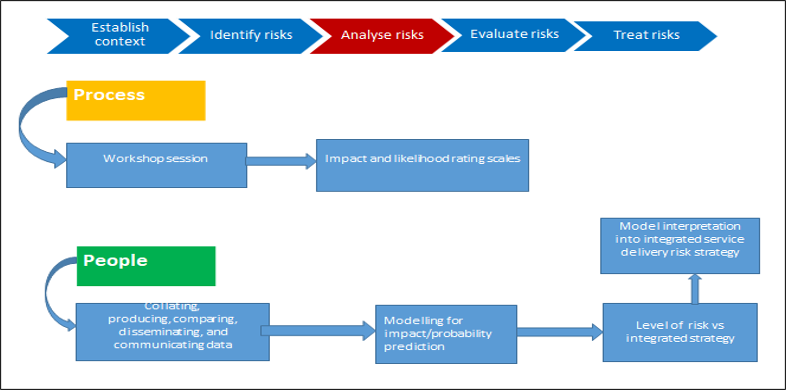From Process to People: An integrated approach to improve quality and performance in Public Sector Organizations

Charlotte Nathi Mhlongo
Managing Director at Keydimensions Risk Solutions, MBA, BComm, Secondary Education Diploma, CRM Prac (theory exam)
‘’If I had one hour to save the world, I would spend 59 minutes defining the problem and one minute finding the solutions” – Albert Einstein
Aligning Enterprise Risk Management with organizational processes to improve service delivery
Public Sector Organizations are facing unprecedented challenges that may impact on service delivery objectives especially as a result of the COVID 19 pandemic. Studies indicate that the impacts of COVID 19 are far-fetched, cutting across all sectors and cannot be fully ascertained at the moment. Surely it may take up to years to understand the extent of damage caused by the pandemic.
The COVID 19 pandemic can be considered as the single root cause to a number of risks ranging from social, economic and others impacting all sectors from banking to maritime and others. However, the Risk Adjusted Strategy approach as a response to the pandemic proved that unity and decisiveness can produce positive results to avert the catastrophe. Never before have we experienced organizations and societies so united with a common purpose. In response to the pandemic, many organizations established cross- functional teams as an indication that none of these risks can be managed in isolation.
The driving single purpose was to minimise the impact of the COVID 19 pandemic on the people as far as possible.
From the social perspective the impacts have already been felt in amongst others the increase in unemployment, decline /loss in income, death of breadwinners to name a few. The major risk at the social front in the South African context other than lives of the people is the delay or even failure of service delivery.
Question: Can the same zeal that is seeing South Africa emerge through (with scars of course) be extended to address the aftermaths of COVID 19 and improve service delivery in Public Sector Organizations? Can the ERM principles help to guide leaders and executives on how to navigate through this challenging time and manage risks triggered by the COVID 19 pandemic? How about service delivery risk assessment?

From risk process to people risk process
A number of processes exist in government institutions (with a bias to municipalities) to enhance quality and pace of service delivery and mitigate the risks to service delivery and improve lives of the citizens.
These processes include, but not limited to
- Accounting and Budgeting Reforms
- Performance Management
- Integrated Development or Strategic Planning
- Anti- fraud and Corruption Programs
- Internal and External Auditing
- Skills Development and Capacity Building
- Urban and Regional Planning
- Back to Basics; and now
- “Enterprise Risk Management” or ERM What next?
These processes have been in existence for over a decade doing their best to address the structural and systemic damages caused to our societies over time with visible achievements here and there. Enterprise Risk Management is the latest addition process to the list. Can it be that COVID 19 reverses the gains made thus far or maybe is an opportunity to reorganise, reinforce and maximise? We know that the Enterprise Risk Management process has an inherent ability to connect different systems and processes.
We have evidenced how the Risk Adjusted Strategy is being applied to manage the impacts of COVID 19 in SA. ERM can serve as a single point of integration to deliver services effectively from an administrative governance position (Risk governance) as well as implementation. At the heart of risk management and risk assessment is risk analysis where the purpose is to understand the impacts and probability of the risk. Risk Analysis further assists in prioritising and directing risk mitigations. Placing the assessed risks on a probability/ impact matrix creates an impactful visual impression. This is a normal risk assessment exercise which may take a strategic turn at a response planning stage where the
choice of a response plan considers strategically and deliberately each of the existing processes as having a specific role in mitigating the risk.
Most risk assessments rely on the workshop to attain risk ratings with outputs being a risk registers. This exercise together with information gathered during the preliminary risk identification gives a good indication which risks should receive priority. The danger is when these priority risks are left at the mercy of the identified risk owner to mitigate, monitor and manage. This may take the process back to silo treatment thus reducing, delaying or even failing the risk process to impact on improving service delivery.
To give further impetus to finding a sustainable solution to the risk, where the initial assessment indicates that the risk may be extremely high, emphasis should be placed on conducting further detailed qualitative and even quantitative analysis using different techniques. Expert groups may be drawn from different processes to form a detailed qualitative understanding of the risk, its probability and impacts.
These individuals must be drawn at levels senior enough to commit the business process into action. Where appropriate and impact/ likelihood is high or the expert group concludes so, the analysis may even extend to the use of quantitative numerical values such as monetary, time or number of lives to assess the impact and probability to the risk. Once a full understanding is in place, a strategic and deliberate exercise should be undertaken to establish the role that each of the already existing processes can play to support in eliminating or mitigating the risk. Some adjustments or refinery or enhancements can be made to existing processes to suit the response strategy to a risk within agreed time frames.
In this context ERM can be defined as
“A formal, structured and systematic tool designed to enhance the pace and quality of existing processes of Service Delivery”
Enterprise Risk Management has its built in system of monitoring, reporting and communication mechanism which can be maximised for the benefit of service delivery.

A practical illustration: Process to People Integrated Risk Analysis
What are key drivers to the integration framework ?
- Tone at the top
- Cross functional teams
- Timing of organisational processes
- Communication and education
- Relationships
- Technology
- A Risk Practitioner
Paradigm shift to service delivery effectiveness: Think possibilities
Thinking the possibilities can help shape the Officially Desired Future (ODF) which is based on the needs and aspirations of the people and expressed adequately using appropriate forecasting techniques.
Thinking possibilities is the ability to diverge a mind from “It never happened before; therefore it cannot happen, to it can happen therefore I must prepare and adjust”.
“Our greatest fear is not that we are inadequate, but we are adequate beyond measure”
Nelson Mandela
Authored by
Charlotte Nathi Mhlongo
Managing Director: Keydimensions Risk Solutions. Keydimensions specialises in Enterprise Risk Management and Business Continuity Consulting and Training
Email: nathi@keydimensions.co.za
Contact: 0799615276 (cell) 031-3091516 (o)



